Serviços Personalizados
Journal
Artigo
Indicadores
-
 Citado por SciELO
Citado por SciELO -
 Acessos
Acessos
Links relacionados
-
 Citado por Google
Citado por Google -
 Similares em
SciELO
Similares em
SciELO -
 Similares em Google
Similares em Google
Compartilhar
DYNA
versão impressa ISSN 0012-7353versão On-line ISSN 2346-2183
Dyna rev.fac.nac.minas v.78 n.168 Medellín out./dez. 2011
EXERGOECONOMIC COMPARISON OF ABSORPTION REFRIGERATION SYSTEMS INCLUDING A HIBRID ABSORPTION-EJECTO COMPRESSION CHILLER
COMPARACIÓN EXERGOECONÓMICA DE SISTEMAS DE REFRIGERACIÓN POR ABSORCIÓN INCLUYENDO UN CHILLER DE ABSORCIÓN-EYECTO COMPRESIÓN
JUAN CARLOS BURBANO JARAMILLO
Mechanical Engineering Faculty, Technological University of Pereira, Pereira, Colombia. jburbano@utp.edu.co
LUIZ FELIPE PELLEGRINI
Escola Politécnica, University of São Paulo, São Paulo, Brazil. luiz.pellegrini@poli.usp.br
SILVIO DE OLIVEIRA JR.
Escola Politécnica, University of São Paulo, São Paulo, Brazil. Silvio.oliveira@poli.usp.br
Received for review November 24th, 2009; accepted December 2nd, 2010; final version December 8th, 2010
ABSTRACT: The study of absorption refrigeration systems has had increasing importance in recent years due to the fact that the primary energy that is used in an absorption system can be heat available from a residual source or even a renewable one. Therefore, these systems not only use energy that would be rejected by the environment, but also they avoid the consumption of expensive fossil or electrical energies. The production cost of the mechanical work necessary to obtain a kW of refrigeration for mechanical compression cycle is normally higher than the cost for recovering the needed heat to obtain the same kW in an absorption cycle. Also, the use of these systems reduces impact on the environment by decreasing the emission of CO2. We intend to show the performance of a hybrid absorption-ejecto compression chiller compared to conventional double- and single-effect water/lithium bromide systems, by means of an exergetic and exergoeconomic analysis of these configurations in order to calculate the exergy-based cost of a final product. The vapor compression refrigeration system is included in the results, as a comparisson to the performance of the absorption refrigeration systems analyzed.
KEYWORDS: Hybrid refrigeration system, absorption ejecto-compression chiller, exergoeconomic analysis
RESUMEN: El estudio de los sistemas de refrigeración por absorción ha tomado una importancia creciente en los últimos años, ya que la energía primaria que es usada en un sistema de absorción puede ser calor disponible de una fuente residual o de una renovable. Por lo tanto, estos sistemas no sólo usan energía que sería rechazada al ambiente sino también, evitan el consumo de energías fósiles o eléctricas costosas. El costo de producción de trabajo mecánico necesario para obtener un kW de refrigeración para el ciclo de compresión mecánico es, normalmente, más alto que el costo para recuperar el calor necesario para obtener el mismo kW en un ciclo de absorción. También, el uso de estos sistemas reduce el impacto ambiental disminuyendo la emisión de CO2. Este artículo pretende mostrar el desempeño de un chiller híbrido de absorción-eyecto compresión comparado con sistemas de absorción convencionales de agua/bromuro de litio de simple y doble efecto, por medio de un análisis exergético y exergoeconómico de estas configuraciones a fin de calcular el costo con base exergética del producto final. Fue incluido un sistema de refrigeración por compresión de vapor en los resultados, como comparación del desempeño con los sistemas de refrigeración por absorción analizados.
PALABRAS CLAVE: Sistema de refrigeración híbrido, chiller de absorción-eyecto compresión, análisis exergoeconómico.
1. INTRODUCTION
Absorption refrigeration systems have had increasing importance in recent years from the energy and environmental viewpoints. Compared with mechanical chillers, absorption chillers have a low coefficient of performance (utility produced divided by energy input). However, absorption chillers can substantially reduce operating costs because they are powered by low-grade waste heat, solar, or biomass energy sources. In addition, absorption refrigeration uses natural substances such as working fluids which do not cause ozone depletion or global warming.
Absorption chillers use heat instead of mechanical energy to provide cooling. A thermal compressor consists of an absorber, a generator, a pump, and a throttling device, and replaces the mechanical vapor compressor. In the chiller, refrigerant vapor from the evaporator is absorbed by a solution mixture in the absorber. This solution is then pumped into the generator. There, the refrigerant re-vaporizes using a waste steam heat source. The refrigerant-depleted solution then returns to the absorber via a throttling device. The two most common refrigerant/absorbent mixtures used in absorption chillers are ammonia/water and water/lithium bromide. Employing this solution, the use of a CFC refrigerant and the consequent environmental damage can be avoided.
Absorption chillers are generally classified as direct- or indirect-fired, and as single-, double-, or triple-effect. In direct-fired units, the heat source can be gas or some other fuel that is burned in the unit. Indirect-fired units use steam or some other transfer fluid that brings in heat from a separate source, such as a boiler or heat recovered from an industrial process.
Low-pressure, steam-driven absorption chillers are available in capacities ranging from 100 to 1500 TR. Absorption chillers come in two commercially available designs: single-effect and double-effect. Single-effect machines provide a thermal coefficient of performance (COP) of 0.7 and require about 8.2 kg of steam at 2.0 bar (abs) per TR of cooling. Double-effect machines are about 40% more efficient, but require a higher grade of thermal input, using about 4.5 kg of steam at 6.9-10.3 bar (abs) per TR [1].
In short, absorption cooling may fit when a source of free or low-cost heat is available, or if objections exist to using conventional refrigeration. Essentially, the low-cost heat source displaces higher-cost electricity in a conventional chiller.
The most commonly used tool to evaluate the refrigeration systems is the first law of thermodynamics, however it cannot show that irreversibility occurs during the energy conversion process throughout the cycle. The exergy method (the second law analysis) is an alternative, based on the concept of exergy. An exergy balance applied to a process or a whole plant tell us how much of the usable work potential, or exergy, supplied as the input to the system under consideration, has been consumed by the process [2]. Exergy analysis predicts the thermodynamic performance of an energy system and the efficiency of the system components by accurately quantifying the entropy generation of the components [3].
Some of works analyzing absorption refrigeration systems found at the literature use second law analysis such as, for example, Misra et al. [4] who apply the theory of exergetic cost to optimize a LiBr/H2O vapor absorption refrigeration system run by pressurized hot water for air-conditioning applications. Misra et al. [5] use the thermoeconomic theory (a combination of second law analysis with economic considerations), applying it to the economic optimization of a single effect water/LiBr vapor absorption refrigeration system for air-conditioning application, aimed at minimizing its overall operation and amortization cost. Adewusi and Zubair [6], use the second law of thermodynamics to study the performance of single-stage and two-stage ammonia-water absorption refrigeration systems when some input design parameters are varied.
Misra et al. [7] apply the thermoeconomic concept to the optimization of a double-effect H2O/LiBr vapor absorption refrigeration system, aimed at minimizing its overall product cost. A simplified cost minimization methodology based on the thermoeconomic concept is applied to calculate the economic costs of all the internal flows and products of the system by formulating thermoeconomic cost balances. Izquierdo et al. [8], make an exergetic analysis of a double stage thermal compressor using the lithium bromide-water solution. The double stage system considered allows for one to obtain evaporation temperatures equal to 5 °C using solar heat coming from flat plate collectors and other low grade thermal sources. The results obtained give the entropy generated, the exergy destroyed, and the exergetic efficiency of the double stage thermal compressor as a function of the absorption temperature.
Palacios et al. [9] intend to show that the chemical exergy is an important portion in the calculation of the total exergy of the solution used in absorption refrigeration systems, and should be taken into account in exergy balances. Gomri and Hakimi [10] show an exergy analysis of double-effect lithium bromide/water absorption refrigeration system and all exergy losses that exist in the absorption system are calculated. Palacios et al. [11] carry out a thermoeconomic analysis of a single and double-effect LiBr/H2O absorption refrigeration system. Gomri [12] presents a comparative study between single-effect and double-effect absorption refrigeration system with identical cold output using the second law.
In this article, an exergoeconomic comparison of a single, double-effect water/lithium bromide system and a hybrid absorption-ejecto compression chiller, which is described in detail in the next section, is carried out in order to calculate the exergy based cost of exergy transferred to chilled water.
2. SYSTEMS DESCRIPTION
In its most simple conception, an absorption machine consists of an evaporator, a condenser, an absorber, a generator, and a solution pump. In an absorption chiller, the compression of the steam refrigerant is effectuated by the absorber, by the solution pump, and by the generator in combination, instead of a mechanical steam compressor.
Figure 1, shows a single effect water/lithium bromide absorption chiller Dühring chart schematic.
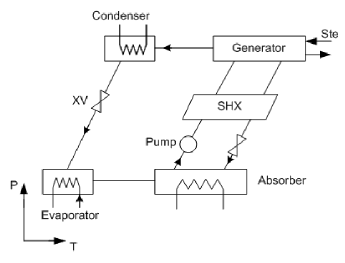
Figure 1. Single-effect water/lithium bromide absorption chiller Dühring chart schematic.
Refrigerant and absorbent in an absorption cycle form what is designated as couple of work. Many couples have been proposed along the years, but only two have been widely used: Ammonia together with water as an absorbent, and water together with an aqueous solution of lithium bromide as an absorbent. The couple ammonia-water is found in applications of refrigeration with low temperatures (lower than 0 °C). The couple water-lithium bromide is very much used in applications for air conditioning, in which it is not necessary to cool below 0 °C.
Single-effect LiBr/H2O absorption chillers use low pressure steam or hot water as the heat source. The water is able to evaporate and extract heat in the evaporator because the system is under a partial vacuum. The thermal efficiency of single-effect absorption systems is low. Most new single-effect machines are installed in applications where waste heat is readily available. Single-effect chillers can be used to produce chilled water for air conditioning and for cooling process water, and are available in capacities from 7.5 to 1500 tons.
2.1. Double-effect water and lithium bromide technology
One of the limitations of single-effect absorption cycles is that they cannot take advantage of the higher availability of high temperature heat sources to achieve a higher COP. The cooling COP of a single-effect water/lithium bromide machine is around 0.7, essentially independent of the heat input temperature [13].
Double-effect absorption chillers are commonly installed in large capacity comfort cooling applications that are also served by centrifugal or screw chillers such as office buildings, hospitals, and universities as well as manufacturing facilities and light industrial process cooling. They are also often used in hybrid plant applications, which involve both electric and absorption chillers, and are an ideal choice where electric rates and/or demand charges are high. Double-effect chillers use two stages of lithium bromide solution reconcentration versus one stage for a single effect machine, which increases efficiency and reduces energy consumption accordingly.
Figure 2 shows a parallel flow double-effect water/lithium bromide chiller Dühring chart schematic.
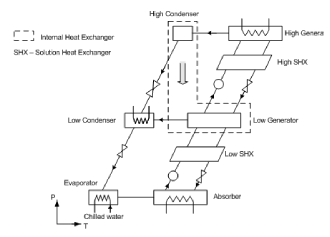
Figure 2. Parallel flow double-effect water/lithium bromide chiller Dühring chart schematic.
Heat is transferred into the cycle in both the higher generator and the evaporator. Heat is transferred out from the cycle in the absorber and low condenser. The double-effect cycle includes two solution heat exchangers that have a similar role in the solution circuits than for the single-effect cycle. A new feature of the double-effect is the internal heat exchange between the high condenser and the low generator. This internal heat exchange is achieved in practice by incorporating these two components into a single transfer device. One side of the exchanger is the high condenser and the other side is the low generator.
2.2. Hybrid absorption-ejecto compression chiller
The absorption-ejecto compression refrigeration system was proposed by Olivera Jr. [14]. The system is characterized by producing chilled water in stipulated conditions, and to have ejectors between the evaporator and absorber. The functioning is similar to the single-effect absorption system, with a variation that consists of using ejectors between the evaporator and absorber. The number of ejectors depends on the steam pressure elevation released in the evaporator. Each ejector operates with a pressure ratio of approximately 2. The ejector exhaust is discharged to the absorber, causing the absorber pressure to be at a level higher than that in the evaporator. Therefore, the concentration of solution within the absorber can be kept from crystallization when the system is needed to operate with a low evaporator temperature or with a high absorber temperature, such as in the case of an air-cooled unit.
Figure 3 shows a water/lithium bromide absorption-ejecto compression refrigeration system. Configurations of absorption refrigeration systems using ejectors are described in [15].
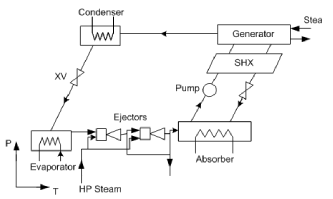
Figure 3. Absorption-ejecto compression refrigeration system Dühring chart schematic.
An ejector works as follows (Fig. 4): the refrigerant vapor at low pressure enters into the ejector at point (1), and it is inhaled by the high pressure steam at point (B) which produces a vacuum when it enters in the ejector at point (2) and goes out at point (A), so it lifts up the pressure two times at the output of the ejector (point 3). This steam at the exit of the first ejector is used by a second ejector to lift its pressure up to the absorber pressure. The steam then is absorbed by the strong solution coming from the generator. The refrigerant steam flow that is not vaporized remains in concentrated solution that is sent to the generator where the water steam is again separated from the solution to flow up to the condenser and to continue the cycle.
Figure 4 shows the evolution of the motive steam and the vapor inhaled throughout the ejector.
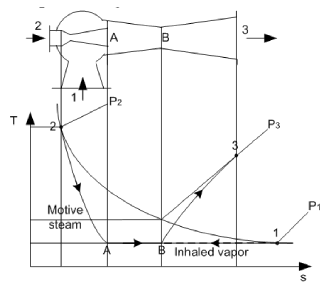
Figure 4. Evolution of motive steam and inhaled vapor throughout ejector (Oliveira Jr., 1991).
To reduce the motive steam consumption, in each ejector exit there is a mass flow deviation sent to the next ejector to be compressed. This flow is always the same as that flowing from the evaporator, so the motive steam mass flow is sent again to the boiler, or it is used in another process, if the pressure conditions allow.
2.3. Cooling System
For all the systems described above, a cooling tower is installed and cooling streams to the absorber and condenser are connected in a series flow arrangement. Series flow piping of the absorber and condenser is preferred by operators since a single pump can be utilized and control problems inherent in a parallel design are avoided [13]. Series flow arrangement can be of two types: condenser first or absorber first. The second one, in which the absorber is first, is the better of the two series designs as far as avoiding crystallization.
Figure 5 shows a cooling system installed for each absorption refrigeration system described here.
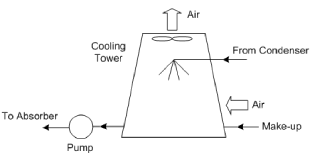
Figure 5. Cooling system for absorption refrigeration systems.
3. MODELING AND SIMULATION
The absorption refrigeration systems developed in this paper are applied to satisfy identical refrigeration capacity and cold output requirements, based on a commercial model (Tab.1).
For the purpose of analysis of absorption refrigeration systems, the following assumptions are made:
- The analysis is made under steady conditions.
- The refrigerant at the outlet of the condenser is saturated liquid.
- The refrigerant at the outlet of the evaporator is saturated vapor.
- The outlet temperatures from the absorber and from generators correspond to equilibrium conditions of the mixing and separation, respectively.
- Pressure losses in the pipelines and all heat exchangers are negligible.
- Heat exchange between the system and surroundings, other than in that prescribed by heat transfer at the high generator (double-effect absorption system), evaporator, condenser, and absorber, does not occur.
- The reference environmental state for systems is water at an environment temperature (To) of 25 °C and 1 bar pressure (Po).
In a hybrid absorption-ejecto compression chiller, and for energy balance in ejectors, the following assumptions were considered:
- adiabatic flow
- the kinetic energy in different points of ejector is negligible
- one-dimensional flow
- steady state
- the thermodynamic state of inhaled vapor does not change when going from point 1 to point A (Fig. 4).
- the vapor pressure at the mixing region of vapors (point A to point B of Fig. 4) is constant
Thus, according with the hypothesis assumed above, and applying the energy balance, the high-pressure steam flow entering into the ejector (based on Fig. 4), can be written as:

The calculus of energy and exergy consumed by the ejector can be calculated according to the operating condition. Thus, considering the output steam of each stage, which is not used by the absorption system, but which can be used by another process, the expressions for specific energy and exergy are, respectively [14]:
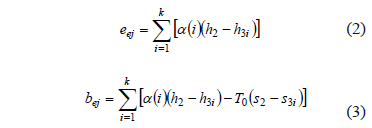
Where k is the number of ejectors and is defined as:

The hybrid absorption-ejecto compression refrigeration system was modeled with two (2) ejectors connected in a series flow arrangement and using a pressure ratio of 1.8.
The assumed parameters used to simulate the absorption refrigeration systems are shown in Tab. 2.
Table 2. Assumed parameters used to simulate the absorption refrigeration system.
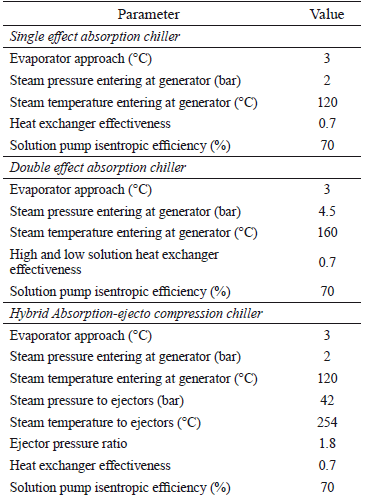
In addition to the assumed parameters for the three absorption refrigeration systems, the parameters shown in Tab. 3 are also considered for the cooling system, which include a cooling tower and a cooling water pump.
Table 3. Assumed parameters for cooling system.
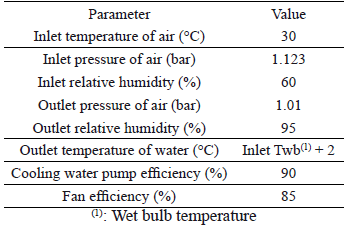
For the exergoeconomic analysis, exergy-based cost (kJ/kJ) is used and defined as:

Where  is the cost rate,
is the cost rate,  is the exergetic rate, and c expresses the average costs per exergy unit of product in consideration (exergy transferred to chilled water in this work). Thus, in order to calculate the exergy-based cost of exergy transferred to chilled water, the balance of exergetic cost is applied to absorption refrigeration systems. It is:
is the exergetic rate, and c expresses the average costs per exergy unit of product in consideration (exergy transferred to chilled water in this work). Thus, in order to calculate the exergy-based cost of exergy transferred to chilled water, the balance of exergetic cost is applied to absorption refrigeration systems. It is:

For systems considered here, the standard chemical exergy of water is used to calculate the chemical exergy of water and its value is taken from [16].
The models presented above were implemented in the Engineering Equation Solver (EES®) [17] and simulated considering a steady-state operation.
4. RESULTS
The coefficient of performance and exergy efficiencies are determined as the ratio of the energy (or exergy) of the product to the energy (or exergy) of the input. In order to calculate the COP and the exergy efficiency of refrigeration systems, the power consumed by the cooling water pump and the cooling tower fan were included. A vapor compression refrigeration system is included in the results, in order to compare with absorption systems.
For evaluating the exergy-based cost (kJ/kJ) of exergy transferred to chilled water, the exergy-based cost for steam and electricity equal to 1 kJ/kJ is considered.
The results obtained for the COP and the exergy efficiency of analyzed refrigeration system are shown in Tab. 4.
Table 4. Results for COP and exergy efficiencies for refrigeration systems, including a vapor compression.
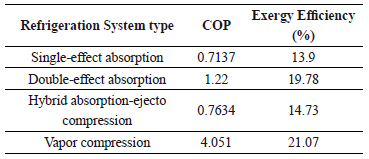
As Tab. 4 shows, the COP of single and double-effect present typical values for these kinds of systems as found in the literature and in commercial models frequently used in trigeneration projects. Hybrid absorption-ejecto compression system presents a better COP and exergy efficiency than a single-effect absorption refrigeration system, showing an improvement of performance with the use of ejectors between the evaporator and absorber and without the complexity of a double-effect absorption chiller, which presents the higher COP and exergy efficiency among the absorption systems. The results of the COP and the exergy efficiency for the hybrid absorption-ejecto compression chiller are influenced by high pressure and temperature steam entering into the ejectors. Parameters chosen for simulation (see Tab. 2) were those that produced better results. The vapor compression refrigeration system presents the best results, as expected, and its exergy efficiency is only comparable with double-effect absorption system.
Table 5 shows a comparison of the exergy-based costs (kJ/kJ) of exergy transferred to chilled water and steam consumption (kg/s), under modelling parameters for the studied refrigeration systems, including a vapor-compression one.
Table 5. Exergy-based costs of exergy transferred to chilled water and steam consumption.
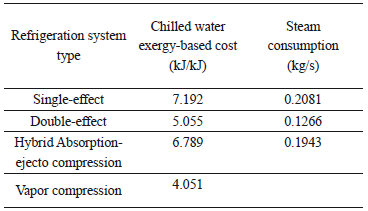
The results for the exergy-based cost of exergy transferred to chilled water show that it is higher in the single-effect chiller, as expected according with the results of the COP and exergy efficiency of the system. The lowest exergy-based cost among the absorption systems is for the double-effect chiller, reflecting its highest exergetic efficiency. For the hybrid absorption-ejecto compression chiller, the exergy-based cost of exergy transferred to chilled water is lower than the single-effect absorption chiller in accordance with higher exergy efficiency. In comparison with the vapor compression chiller, all absorption systems have a higher exergy-based cost of exergy transferred to chilled water and the cost of the basic energy is the only factor that determines the possible competitiveness of the absorption systems versus those of mechanical compression.
Steam consumption is also reflected by the exergy efficiency of refrigeration systems. In Tab. 5, high pressure steam consumption for ejectors does not appear due to the fact that it is very small, 0.02942 kg/s, each ejector with a steam consumption of 0.01399 kg/s. In vapor compression refrigeration systems, the power consumption of the compressor is 78.32 kW.
In general terms, the results for single and double-effect absorption refrigeration systems are comparable with other works reviewed in the introductory part of this article using different methodologies or assumptions in order to obtain the exergy-based cost of the product. The results for the hybrid absorption-ejecto compression systems show how it is possible to improve the performance of an absorption refrigeration system with relative simplicity by means of ejectors.
5. CONCLUSIONS
The performance of a hybrid absorption-ejecto compression chiller compared to conventional double and single-effect water/lithium bromide systems, by means of an exergetic and exergoeconomic analysis was made in this article. A hybrid absorption-ejecto compression system uses ejectors between the evaporator and absorber, causing the absorber pressure to be at a level higher than that in the evaporator. It has an advantage when the system is needed to operate with a low evaporator temperature or with a high absorber temperature, such as in the case of an air-cooled unit. The results show that a hybrid absorption-ejecto compression chiller is a good alternative for chilled water production because the COP and exergetic efficiency is higher than a single-effect absorption refrigeration system; and in spite of having a lower COP and exergetic efficiency that a double-effect absorption system, it does not have the same complexity since the hybrid absorption-ejecto compression chiller uses ejectors that have some advantages like: the cycle has no moving parts (except a solution pump), simplicity of operation, reliability, and low maintenance cost. From an exergoeconomic analysis, it is clear that chillers having only one product will charge this with all the costs associated with its formation process. Thus, results obtained using different methodologies or assumptions could be very similar.
It is clear that the best performance is demonstrated by the vapor compression refrigeration system, but the cost of producing the mechanical work necessary to obtain a kW of refrigeration for mechanical compression cycle is normally higher than the cost necessary for recovering the heat quantity necessary to obtain the same kW in an absorption refrigeration system. In general terms, absorption chillers may be worth considering if a site requires cooling and a source for free or low-cost heat is available, because of its low COP and exergy efficiency. The authors are especially interested in studying these refrigeration systems as part of trigeneration systems research, where a combined heat and power unit cannot use all of the available heat or if a new CHP is being considered.
6. REFERENCES
[1] ABSORPTION CHILLERS. 2009. Available in: http://www.absorptionchillers.com/. Accessed in May of 2009. [ Links ]
[2] KOTAS, T. J. "The Exergy Method of Thermal Plant Analysis". London, Butterworths. 1985. [ Links ]
[3] KWAK, H.-Y., KIM, D.-Y., JEON, J.-S. "Exergetic and thermoeconomics analyses for power plant". Energy, 28 (2003) p. 343-360. 2003. [ Links ]
[4] MISRA, R.D., SAHOO P.K., GUPTA, A. "Application of the exergetic cost theory to the LiBr/H2O vapour absorption system". Energy, 27. p. 1009-1025. 2002. [ Links ]
[5] MISRA, R.D., SAHOO, P.K., SAHOO, S., GUPTA, A. "Thermoeconomic optimization of a single effect water/LiBr vapour absorption refrigeration system". International Journal of Refrigeration, 26. p. 158-169. 2003. [ Links ]
[6] ADEWUSI, S.A., ZUBAIR, S. M. "Second law based thermodynamic analysis of ammonia-water absorption systems". Energy conversion and management, 45. p. 2355-2369. 2004. [ Links ]
[7] MISRA,R.D., SAHOO P.K., GUPTA, A. "Thermoeconomic evaluation and optimization of a double-effect H2O/LiBr vapour-absorption refrigeration system". International Journal of Refrigeration, 28. p. 331-343. 2005. [ Links ]
[8] IZQUIERDO, M., VENEGAS, M., GARCÍA, N., PALACIOS, E. "Exergetic analysis of a double stage LiBr-H2O thermal compressor cooled by air/water and driven by low grade heat". Energy conversion and management, 46. p. 1029-1042. 2005. [ Links ]
[9] PALACIOS, R., GONZALES, R., NEBRA, S. A. "Exergy calculation of lithium bromide water solution (LiBr H2O)". Proceedings of ECOS 2007. Padova, Italia. v. 1. p. 407-414. 2007. [ Links ]
[10] GOMRI, R., HAKIMI, R. "Second law analysis of double effect vapour absorption cooler system". Energy conversion and management, 49. p. 3343-3348. 2008. [ Links ]
[11] PALACIOS, R., GONZALES, R., NEBRA, S. A. 2008. "Thermoeconomic analysis of a single and double-effect LiBr/H2O absorption refrigeration system". Proceedings of ECOS 2008. Cracow, Poland. p. 287-298. [ Links ]
[12] GOMRI, R. "Second law comparison of single effect and double effect vapour absorption refrigeration systems". Energy conversion and management, doi:10.1016/j.enconman.2009.01.019. 2009. [ Links ]
[13] HEROLD, KEIT, RADERMACHER, REINHARD, KLEIN, SANFORT. "Absorption Chillers and Heat Pumps". CRC press. 1996. [ Links ]
[14] OLIVEIRA JR., S. "Upgrading industrial thermal effluents - exergetic, entropic and economic analysis" In French. Doctoral thesis. Polytechnic National Institute of Lorraine, France. 1991. [ Links ]
[15] SRIKHIRIN, P., APHORNRATANA, S., CHUNGPAIBULPATANA, S. "A review of absorption refrigeration technologies". Renewable and Sustainable Energy Reviews 5 p. 343-372. 2001. [ Links ]
[16] SZARGUT, J., MORRIS, D.R., STEWARD, F.R. "Exergy analysis of thermal, chemical, and metallurgical processes". Hemisphere Publishing Co, New York, 1988. [ Links ]
[17] F-CHART, EES® Engineering Equation Solver. 2008. [ Links ]















